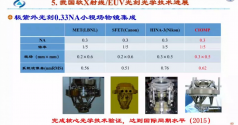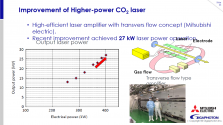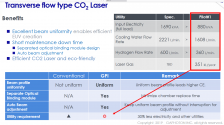You are using an out of date browser. It may not display this or other websites correctly.
You should upgrade or use an alternative browser.
You should upgrade or use an alternative browser.
Chinese semiconductor industry
- Thread starter Hendrik_2000
- Start date
- Status
- Not open for further replies.
D
Deleted member 24525
Guest
你觉得我的读汉字的能力那么高啊?
Is about the commercialization of EUV light sources.Do you think my ability to read Chinese characters is so high?
Translated.

There are three main companies engaged in EUV in China as per this paragraph.
1. Shanghai Guang
2. Guangdong Institute of Intelligent machinery along with Huazhong university of science and technology
3. Tsinghua University
but they forgot to write the name of another very important institute.
4. Changchun Institute of Optics, Fine Mechanics and Physics is also deeply involved in EUV light source development.
its pleasure to see multiple institutions currently working on EUV light source.
D
Deleted member 24525
Guest
Surprised at the relative cheapness of the ssmb plant. Hope the part about its construction period being short is true.Translated.
View attachment 112728
There are three main companies engaged in EUV in China as per this paragraph.
1. Shanghai Guang
2. Guangdong Institute of Intelligent machinery along with Huazhong university of science and technology
3. Tsinghua University
but they forgot to write the name of another very important institute.
4. Changchun Institute of Optics, Fine Mechanics and Physics is also deeply involved in EUV light source development.
its pleasure to see multiple institutions currently working on EUV light source.
I don't remember if SIOM or CIOMP that is involved in the first one but I know CIOMP is more involved in the development of the optics and projection objective lens than in the light source.but they forgot to write the name of another very important institute.
4. Changchun Institute of Optics, Fine Mechanics and Physics is also deeply involved in EUV light source development.

CIOMP lithography technologies developed this year.
-Ultra-high-precision lithography machine projection objective lens system wave aberration detection technology.
-Extreme Ultraviolet Lithography Optical Technology
-High-precision magnetorheological polishing technology for complex curved optical components.
-Key technologies for surface pollution prevention and non-destructive cleaning of multi-layer film optical components in EUV lithography machine.
Loongson Zhongke: The first SoC integrating Loongson’s self-developed GPGPU is expected to be taped in Q1 next year
News On May 16, at the 2022 and 2023 first quarter performance and cash dividend briefing of Loongson Zhongke, Hu Weiwu, chairman of Loongson Zhongke, announced that the first integrated Loongson self-developed GPGPU (general-purpose graphics processor) A SoC chip is expected to be taped out in the first quarter of 2024.
"At present, the relevant IP research and development has been basically completed, and comprehensive verification is being carried out. On this basis, in the second half of 2024, the tape-out of a dedicated chip that takes into account graphics card and computing power acceleration functions will be completed." Hu Weiwu further said.
In addition, he also said that Godson will continue to increase the main frequency, but will not follow Intel's current technical route of sacrificing efficiency for frequency, and will strive to continue to reduce costs and power consumption at the 3GHz level. "By 2024, Loongson will tap out the first large and small core synergy chip. The next generation of Loongson 3A6000 is 3B6000, which will include four large four small eight cores and built-in self-developed GPGPU."
Fiber lasers have much shorter wavelengths ~1 um instead of 10.6 um for CO2 and are easier to build to high power.
Simply put, fiber lasers win by far on energy efficiency with a 30-50% power conversion rate vs. the 10-15% achieved by CO2 lasers. Higher energy efficiency means reduced electrical expenses.
One thing to consider is the IR absorbance spectrum of Sn.

It looks like a maximum in absorbance at ~1000 cm-1 (~10 um) and low absorbance at lower wavelengths (higher wavenumber). Interestingly, the Sn absorbance spectrum was the only one that is not normalized. If it is indeed normalized, then the absorbance is ~50% at 10.4 um. Assuming reflectance is 0 here.
I couldn't find a mid IR absorbance spectrum of either pure Sn nanoparticles or a reflection spectrum of Sn sheet. Here's a UV-VIS-NIR reflectance spectrum. I'll assume that there's only reflectance and absorbance, no transmission, in this case.

So we have at best ~20% absorbance at fiber wavelengths.
That is interesting.Fiber lasers have much shorter wavelengths ~1 um instead of 10.6 um for CO2 and are easier to build to high power.
One thing to consider is the IR absorbance spectrum of Sn.

It looks like a maximum in absorbance at ~1000 cm-1 (~10 um) and low absorbance at lower wavelengths (higher wavenumber). Interestingly, the Sn absorbance spectrum was the only one that is not normalized. If it is indeed normalized, then the absorbance is ~50% at 10.4 um. Assuming reflectance is 0 here.
I couldn't find a mid IR absorbance spectrum of either pure Sn nanoparticles or a reflection spectrum of Sn sheet. Here's a UV-VIS-NIR reflectance spectrum. I'll assume that there's only reflectance and absorbance, no transmission, in this case.

So we have at best ~20% absorbance at fiber wavelengths.
I already posted this but this is a bit more information in the research literature about the types of lasers that Huazhong had been developing.
Huazhong University of Science and Technology has successfully developed a series of cross-flow CO 2 lasers with powers of 2 kW, 5 kW, and 10 kW, and successfully commercialized more than 100 sets of high-power cross-flow CO 2 laser processing systems [ ] . Pan Qikun et al [ ] proposed a laser power stabilization method and a laser power amplification system, which effectively improved the output narrow pulse width laser power and the stability of each pulse energy after CO2 laser amplified power . Later, the team proposed a dual-wavelength laser coaxial output system, which solved the problem that tunable CO 2 lasers cannot output dual wavelengths at the same time, and at the same time improved the dual-wavelength CO 2 laser in the EUV lithography light source in the MOPA system. The power extraction efficiency and the consistency of the dual-wavelength CO 2 laser beam quality, polarization degree, and transmission direction in [ - ]
Looks like a similar concept than Gigaphoton-Mitsubishi lasers.


that is a huge amount of cooling water and power draw. For 25 kW CO2 laser power, 400 kW is a incredible amount of power to draw into a single tool, and 375 kW of heat is an incredible amount of power dissipated.That is interesting.
I already posted this but this is a bit more information in the research literature about the types of lasers that Huazhong had been developing.
Looks like a similar concept than Gigaphoton-Mitsubishi lasers.
View attachment 112735
View attachment 112734
Fiber lasers are also intrinsically easier to modulate than CO2 lasers. A fiber driven LPP-EUV source would be cabbagizing it.
- Status
- Not open for further replies.

